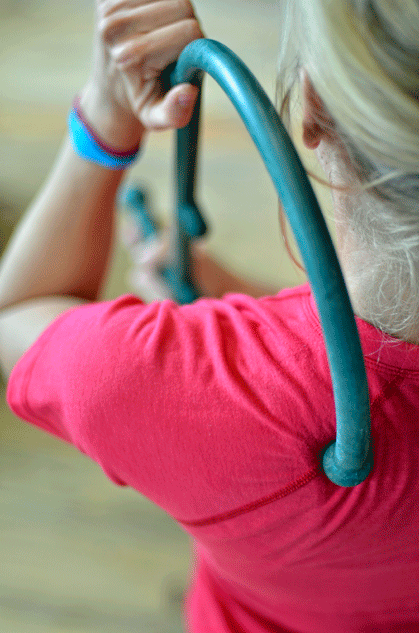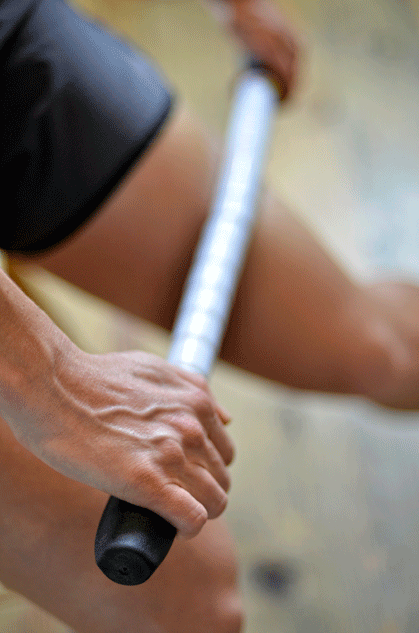Learn Self Massage to Run and Feel Better

(Photo: Getty Images)

The road to healthy running isn’t the same for everyone. Some runners are genetically gifted with optimal physiology, while others struggle to put in even a few miles without encountering an injury. Treating and preventing injuries may include a myriad of techniques and therapies, such as stretching, strength work and physical therapy.
While those treatments work for some, a growing number of runners are discovering real relief in massage. In fact, a recent study out of McMaster University in Hamilton, Ontario showed, for the first time, how effective massage might be. This research, published in Science Translational Medicine, had participants exercise and then gave them a 10-minute massage on one quadriceps, but not the other. After taking muscle biopsies of both legs, the results revealed that the side that received the massage had reduced inflammation.
This means that the healing process post-exercise was kick started more quickly, allowing for damaged muscle tissue to begin repairing. What’s more, massage is something you can do on your own, free of charge, even at home or in your office chair.
RELATED: 7 Rules For Recovering After A Hard Run
What’s the Rub?
Tiana Cain, a trail buff who trains in Greenville, South Carolina, is one of those runners. After visiting a massage therapist for a leg injury, Cain says her entire body benefited. “Not only was massage therapy more cost effective than physical therapy, it had benefits that went beyond helping that particular injury,” she explains. Since then, she has added regular self massage to avoid injury and stay loose and ready to run.
Similar to Cain, Ray Churgovich, a trail ultrarunner in Boulder, Colorado, says that massage played a major role in making running possible for him. “There was a point where my shin splints were so bad that it was impossible to distinguish the pain between my muscle and bone,” he explains. “Massage helped break down the build up of unhealthy tissue.”
David Abookire, the Director of Therapies for Boulder Therapeutics and massage therapist for the Colorado Rapids, says that massage assists in injury prevention and, in turn, improves training. “The pounding, your gait and your own physiology can all lead to various issues and imbalances that can cause injury.” He says massage can help combat everything from shin splints to Achilles tendonitis to back pain, by improving circulation, eliminating tight spots and working out adhesions and scar tissue that impede optimal functioning.
While prevention is the best option, injuries are still bound to happen. When scar tissue build-up in the soft tissues is neglected long enough, problems often result. Through hands-on massage or the use of a self-massage tool, like a foam roller, these fibers are broken up and reabsorbed, thereby restoring the original state of the tissue. Through this process, proper movement patterns are reintroduced, allowing the athlete to avoid secondary injuries that can occur as a result of overcompensation. For instance, if scar tissue has built up around your hip, you may not be effectively swinging your leg forward with each step. By restoring full movement to the hip joint, you’re better able to maintain a healthy gait.
Abookire emphasizes that while regular professional massages are most beneficial, at-home massage is important for sustained running health. “I can give you the greatest treatment ever, but if you go home and don’t do the maintenance, the problem won’t get solved,” he explains.
Self-Massage Guidelines
Although professional massage can be pricey, Abookire recommends making once-a-week or bi-monthly visits during the four to six weeks of your peak training block. Similar to stretching, it is best to make time for self massage post run when muscles are warm. Depending on your injury history, perform a light self massage routine five to six days a week.
Churgovich has an arsenal of massage tools, including a foam roller, The Stick, a foot roller and a lacrosse ball. Depending on what ails you, consider the following self-massage tools and techniques to help keep you healthy and moving forward. Begin by gently massaging each area for 30 seconds to a minute and increase the intensity as your body adapts.

Tool: Foam Roller
Area: Quadriceps, hamstrings, illiotibial (IT) bands
Start with your IT bands. Lie sideways on the ground with your left leg on top of your right leg and lift your body up to place the foam roller beneath you, perpendicular to your body. Put your weight on the roller just below your right hip and brace yourself on the floor with your right arm. Slowly roll the device down toward the side of your knee, then roll back up toward your hip. Similarly, lie face up to roll out your hamstrings and face down to roll out your quads.
RELATED: A Beginner’s Guide To Foam Rolling
Tool: The Stick
Area: Calves, hamstrings, quadriceps
The little brother to the foam roller, the stick is used in a similar fashion. However, instead of relying on body weight, you use your upper body. This is particularly good for the calves, which are hard to massage with the foam roller.
Tool: Golf Ball
Area: Plantar fascia (arch)
Place your foot on top of the golf ball, and make circles around the heel area and then lengthen strokes towards your forefoot. If you have a tight area, pause on top of it and apply a bit of extra pressure. Begin by sitting and as your body can tolerate it, apply more weight. Be careful to avoid pushing too hard and causing bruising.
Tool: Lacrosse Ball
Area: Back and Shoulders
Put your lower back on top of the ball on the floor or a hard surface. Focus on circular and linear movements on tight spots and work your way up toward the trapezius muscles of the upper back. If a lacrosse ball feels too firm, start with a tennis or racquet ball.
Tool: Tennis Ball
Area: Glutes
Begin by sitting on the ball at a set point and roll towards your hip. Go back to that point and roll toward your back. Your body should be facing a different direction at the end of each roll. Since this is an area that can handle deeper massage, switch to a lacrosse ball if the tennis ball isn’t dense enough.